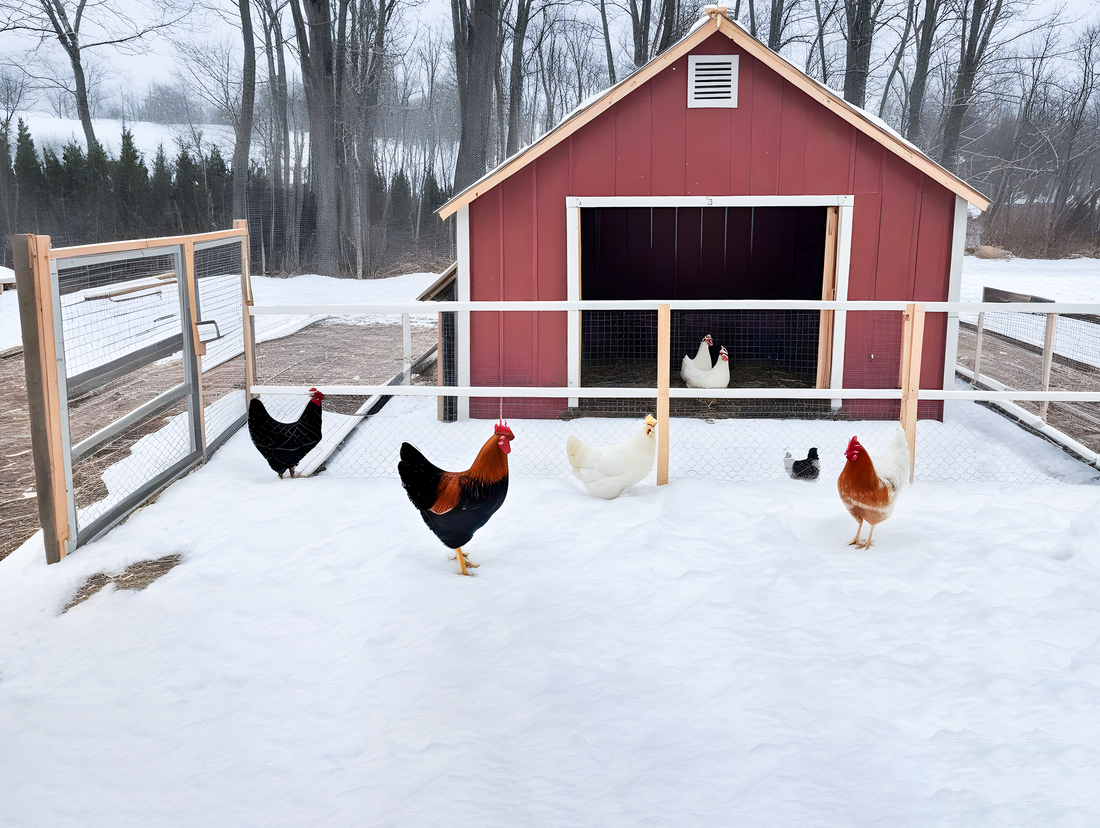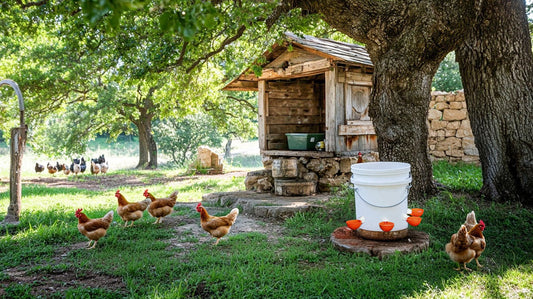Preparing your Chicken Coop for Colder Months
As the winter chill sets in, poultry keepers find themselves faced with the responsibility of ensuring the health and well-being of their feathered companions during the colder months. In this in-depth guide, we'll delve into the essential tips and practices to help you optimize the welfare of your flock and prepare your chicken coop for winter, such as covering insulation, draft prevention, and heating options. So grab your feathered companions, cluckle up, and let’s embark on a journey to create the ultimate winter haven for your clucky companions.
1. Coop Construction - The Key to Thermal Tranquility
Start with the basics – ensuring your coop is a fortress against winter's chill and transform your chicken coop into a winter wonderland! It's the perfect time to unleash your inner interior decorator, give the coop a makeover, and create a cozy environment for your feathered friends.
• Draft-proofing: The Battle Against Cold Air Infiltration
Drafts are the arch-nemesis of a well-insulated coop. Start by thoroughly inspecting your chicken coop for any gaps, cracks, or holes. Seal these potential entry points with weather-stripping, caulking, or other suitable materials. Pay close attention to windows, doors, and joints, ensuring that your coop becomes an impenetrable fortress against cold drafts. Don't let the cold breeze ruffle your chickens' feathers!
Tip: Utilize a smoke pencil or incense stick on a windy day to detect elusive drafts, enabling precise identification of leakage points.
• Insulation: The Science of Heat Retention
Insulation is the backbone of a warm chicken coop. Line the walls with materials like straw, hay, or recycled newspaper to keep the warmth in and the cold out, providing an effective barrier against temperature fluctuations. Ensure proper ventilation to prevent moisture buildup, as excessive condensation can counteract insulation efforts.
A well-insulated coop not only retains heat but also minimizes energy consumption, benefiting both your chickens and your wallet. Insulation isn't just for your house; it's for your chickens' pad as well.
Insulation Pro Tip: Consider using reflective materials such as radiant barriers to enhance heat retention by reflecting radiant heat back into the coop.

• Cozy Corners: Optimal Comfort and Nesting Strategies
Creating comfortable corners within the coop is essential for your chickens' well-being. Employ deep bedding made of materials like straw or wood shavings to provide insulation and comfort. Enhance nesting areas with fresh bedding to cater to the natural instincts of broody hens. This not only ensures warmth but also promotes a hygienic living environment.
Bedding Insight: Monitor bedding regularly, replacing it when damp to maintain a dry and sanitary coop environment.
• Heaters: Calculated Warmth Without Overheating
If the temperature is dropping faster than a clumsy chicken's egg, consider opting for panel heaters for your coop, which can be valuable allies during extremely cold weather.
Unlike traditional heat lamps that have been a go-to option for many poultry keepers, panel heaters present a better alternative, offering a safer, more energy-efficient, and evenly distributed heat source for your chicken coop during winter. Just position the panel heater at an optimal height within the coop for effective heat distribution—ensuring a cozy and secure environment for your feathered friends throughout the colder months. So, embrace the warmth of panel heaters and watch your chickens thrive in comfort and safety this winter.
Caution: Check the manufacturer's guidelines for electrical requirements and safety precautions. Avoid using extension cords or power strips that may not handle the load, and never overload electrical circuits.

• Winterizing the Run: Balancing Outdoor Exploration and Protection
Chickens love a good snow day, but that doesn't mean they want to freeze their tail feathers off. Make sure their outdoor run is equipped with windbreaks and clear pathways. Employ materials such as tarps or clear plastic to shield against biting winds, and spread straw or wood chips to prevent icy surfaces. Prioritize the safety of your chickens while allowing them to indulge in winter exploration.
Friendly reminder: Chickens aren't equipped with snow boots. Clear a path to prevent any accidental chicken slip 'n' slides.
2. Warm, High Calorie Nutrition - The Perfect Winter Menu for Chilly Chickens
As external temperatures drop, chickens experience increased metabolic demands to generate heat, potentially affecting their overall well-being. Hence, winter nutrition has become pivotal for maintaining the health and productivity of your chickens.
Consider adjusting their diet to include more calories to support the heightened energy requirements. Supplement their regular feed with grains, seeds, and mealworms, providing a well-rounded, energy-rich menu.
Also, don’t forget to consult with a poultry nutritionist to formulate a winter-specific diet, addressing potential deficiencies in vitamins and minerals. Proper nutrition ensures strong immune systems and steady egg production.
3. Hydration Hacks - Preventing the Perils of Frozen Water
One of winter's greatest challenges is ensuring your flock stays hydrated and it is often overlooked during winter. Invest in heated waterers to prevent water from freezing and to ensure your chickens have constant access to clean, unfrozen water.
Adequate hydration is crucial for digestion, egg production, and overall health during the colder months. Explore the behavioral patterns of chickens in winter regarding water consumption and learn how to encourage consistent hydration.
4. Combating Frostbite - A Battle Against the Bitter Cold
Frostbite is a real concern for chickens in winter, especially in extremities like combs and wattles. Apply petroleum jelly to these vulnerable areas to create a protective barrier. Additionally, consider adjusting the lighting in the coop to promote blood circulation, helping to ward off frostbite.
5. Poultry Playtime - Enrichment Strategies for Winter Months
Winter often brings confinement, but mental and physical stimulation remains vital. Keep your flock entertained with some exciting indoor activities. Hang a mirror in the coop so they can admire their fabulous feathers or scatter grains for your flock to forage. You can even set up a mini obstacle course for them to navigate – bonus points for creativity!
Stimulated chickens are not only happier but also less prone to pecking and other behavioral issues. You'll also have the most athletic chickens on the block.
6. The Science of Light - Managing Daylight for Winter Health
Shorter days mean less natural light, which can impact egg production and overall well-being. Supplemental lighting in the coop can mimic natural daylight hours, encouraging egg-laying and maintaining the circadian rhythms crucial for your flock's health.
6. Health Monitoring and Disease Prevention
Winter can exacerbate existing health issues and expose chickens to additional risks. Vigilant monitoring and preventive measures are crucial. Conduct regular health assessments and monitor your chickens for signs of illness, especially respiratory issues, and be proactive in treating any ailments.
Pay attention to signs of distress, frostbite, and weight loss. Early detection can prevent escalation of health issues. Since winter confinement increases the risk of disease spread, implement strict biosecurity measures to prevent the introduction of pathogens to your flock.
Educating yourself on these winter poultry care essentials will equip you to navigate the colder months with confidence. Remember, a well-cared-for flock in winter is a thriving flock come springtime.
Winter poultry care doesn't have to be all feathers and fuss. With a bit of creativity, some warm treats, and a dash of care and attention, you can turn the coldest months into a cluckin' good time for your feathered friends. You are not only creating a warm haven for your chickens but also fostering an environment conducive to their overall happiness and productivity. So, go ahead, and give your feathered friends the winter wonderland they deserve! Your chickens will thank you with a chorus of grateful clucks. Happy winter poultry parenting, and may your coop be warm and your eggs be plentiful!







